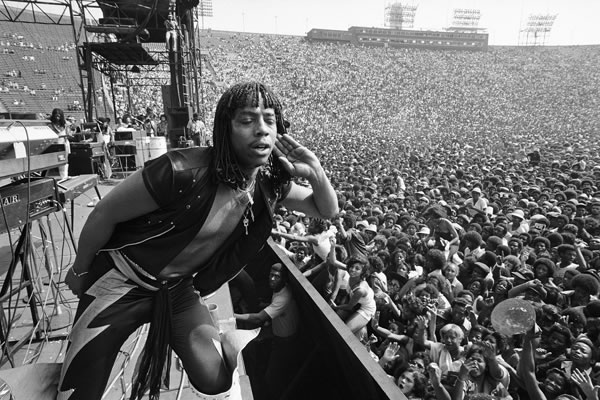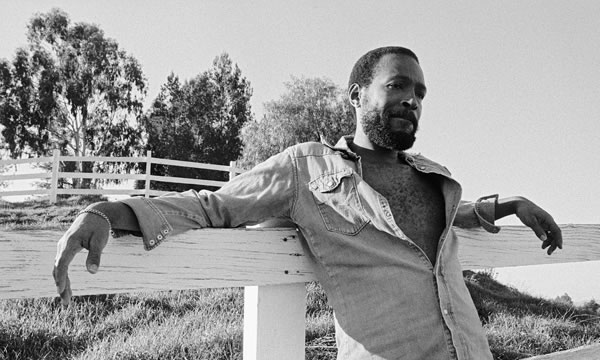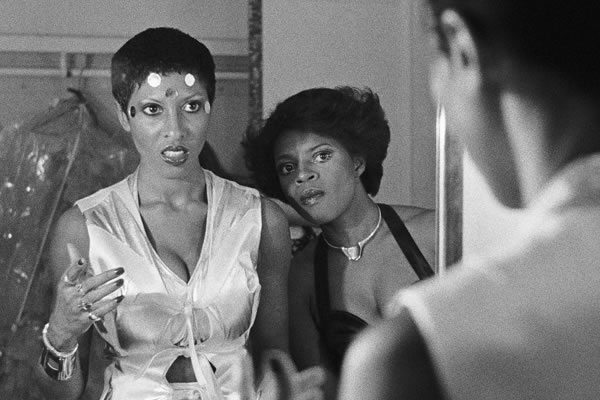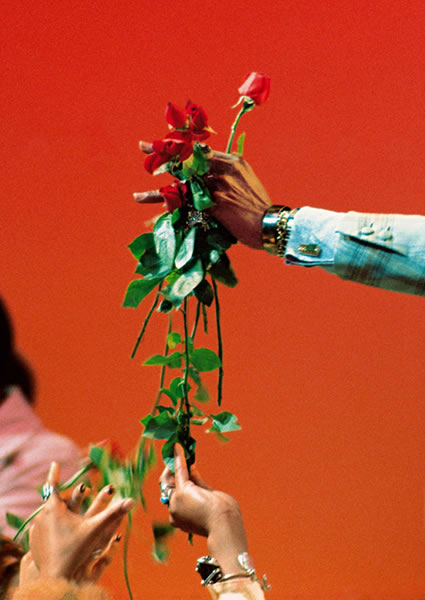Iconic Photos By Bruce Talamon: From Chaka Khan And Stevie Wonder To Earth, Wind And Fire
Talamon’s book, ‘Bruce W. Talamon: Soul. R&B. Funk.’ captures quiet moments with the biggest stars of Seventies soul
9/26/2018 by Elias Leight (rollingstone.com)

Rick James in 1977, one of many vital photos that appears in the new book ‘Bruce W. Talamon: Soul. R&B. Funk.’
Bruce Talamon
“There’ve been photo books on jazz; there’ve been countless photo books on rock and roll, on the Rolling Stones, on Bruce Springsteen. Think about it, all those books that have been done. And there has never been a photo book done on R&B or soul or funk music. I’m the guy that’s got the photographs.”
That was the gist of the email that Bruce Talamon sent the art book publisher Taschen in the small hours of the morning after a glass of wine in 2015. His photos – a treasure trove of funky history snapped between 1972 and 1982 – are collected in Bruce W. Talamon: Soul. R&B. Funk., an indispensable volume which came out this month.
The late-night, spur-of-the-moment message was the culmination of a frustrating period for Talamon. “I consider myself a visual documentarian, a keeper of black folks’ culture and, in this case, our music,” he says. But no one seemed interested in that culture or music, despite hundreds of marvelous images – a should-be iconic shot of Marvin Gaye, shirt half unbuttoned, staring across his ranch in 1978; a gritty picture showing a spent Al Green collapsing backstage after an all-consuming performance, also in 1978; an ecstatic image of Stevie Wonder engaged in a gleeful, off-the-cuff jam with Johnny Pacheco and the Fania All-Stars in 1977.

“My agent took this around to all the big shops in New York and nobody got it,” Talamon says. “Nobody wanted to pull the trigger and do a deal. The response was totally underwhelming.” This lack of interest wasn’t necessarily surprising, though. “Traditionally black music has been underrepresented by the music press,” Talamon says.
When he started as a photographer, working for SOUL Newspaper, an L.A. weekly under the guidance of Regina Jones, he saw firsthand the representational imbalance in the media. “Most of the music photographers on the scene in Los Angeles were white,” he says. “You would see them at the big concerts. You’d see them at the Jackson 5; you’d see them for Diana Ross. But you wouldn’t see them with the Dramatics. If your clients aren’t buying photographs of LTD or the Whispers, why would you go out and photograph them? In all my years coming on Soul Train, I hardly ever saw white photographers coming on to photograph some of these acts.”
This imbalance was mirrored on the record labels, even ones that had a number of black artists on their roster. “In some cases at some of these big record companies they didn’t even have black publicists for a long time,” Talamon says. “There was a lot of scrutiny for us, for SOUL Newspaper, to come in there and photograph some of these artists. The artists loved us, but some of the publicists, the gate keepers, they were sort of like ‘who’s this?’ ‘Cause we weren’t white.”
But Talamon earned the backing of black gatekeepers like Don Cornelius, of Soul Train, a nationally syndicated television program that celebrated R&B every week starting in 1971. “Don would support other black entrepreneurs,” Talamon says. “I could come on, even without an assignment, and it was, ‘Hello Bruce, how you doing?'” So when the show dedicated an entire episode to Al Green, Talamon was on hand to capture one of history’s greatest singers during his aesthetic peak. In the early Eighties, he did a stint as Soul Train’s house photographer.
Talamon also kept winning artists’ approval. Donna Summer loved working with him on a SOUL Newspaper shoot, so she had him shoot her Ebony cover as well. Maurice White liked Talamon’s photographs so much he decided to bring him around the world on tour with Earth, Wind & Fire. During a road trip with Labelle, “Nona [Hendryx] and Sarah [Dash] were extremely welcoming, and at the appropriate time, they allowed me into their dressing room as they were glamming up to go out there and knock that crowd out.”

Similar stories are peppered throughout Bruce W. Talamon: Soul. R&B. Funk. When the photographer spent a week with Marvin Gaye, the star – without prompting – drove Talamon out to his ranch and introduced him to his mother, who made them lunch from Thanksgiving leftovers. “He’s popping his mother with a damn towel like you used to do in the locker room,” Talamon remembers. “He was totally relaxed. All the craziness was left at the front door.”
This level of access is hard to imagine now. “Think about that photograph of Teddy Pendergrass – I shot that outside of a hotel because, on a whim, the A&R guy said, ‘hey, let’s get some pictures on the street,'” Talamon says. “We were in front of the Bonaventure Hotel, no permits, no police escort, no security, and you’ve got one of the biggest male stars. Try doing that with Jay-Z or Kanye [West] today.”
Talamon’s knack for finding these moments and capturing them with his camera was crucial to his mission. “My position was, from the start, this was more than just screaming into the microphone,” he says. “Okay, you shot that. But now you need the private dance, you need the rehearsals, the sound-checks, the studio time, the stuff when folks exhaled. This book is a little different because you’ve got stuff leading up to the performance.”
Without photographic evidence of that preparation and those exhales, stars often seem one-dimensional, but personal narrative was not a courtesy offered to many black singers. “You think about Maurice White and Michael Jackson and Curtis [Mayfield] and Teddy – they worked,” Talamon says. “Oh God, they worked. I don’t think people really understood that because they didn’t see this kind of photography.” Several pictures capture Parliament – a frequent subject on these pages – in the process of building a massive stage at the Los Angeles Coliseum. “A lot of people don’t associate this period [in funk] with the big shows like Queen was doing or like Emerson, Lake & Palmer were doing,” Talamon says. “1977 on the P-Funk Earth Tour, you’ve got 100,000 people.”

While that photo adds important mass-scale context, one of the best pictures in Bruce W. Talamon: Soul. R&B. Funk. is decidedly more intimate. The night that Green came to Soul Train, female fans clustered near the stage hoping that the star would hand them a rose, as he traditionally did at performances. (Green still does that today.) As the singer moved towards the end of the stage to pass out flowers, Talamon prepared to shoot. “If you see it, it’s passed — you need to anticipate,” he says. But photo technology was rudimentary compared to what it is today – he wasn’t using a zoom lens because most zooms were too slow. “I was shooting a wide shot when this whole thing started to unfold. I was able to get basically a three-quarter shot, and then I cropped it.”
Green is not in the final picture – you see his clenched fist, full of roses, and a host of fans’ hands are rising to meet it. “Even though you don’t see his face, there is emotion and desperation; the hands are clawing for the rose being offered. We blew it up, and it just sings.” But no one could hear it, or more importantly, see it, until now.


